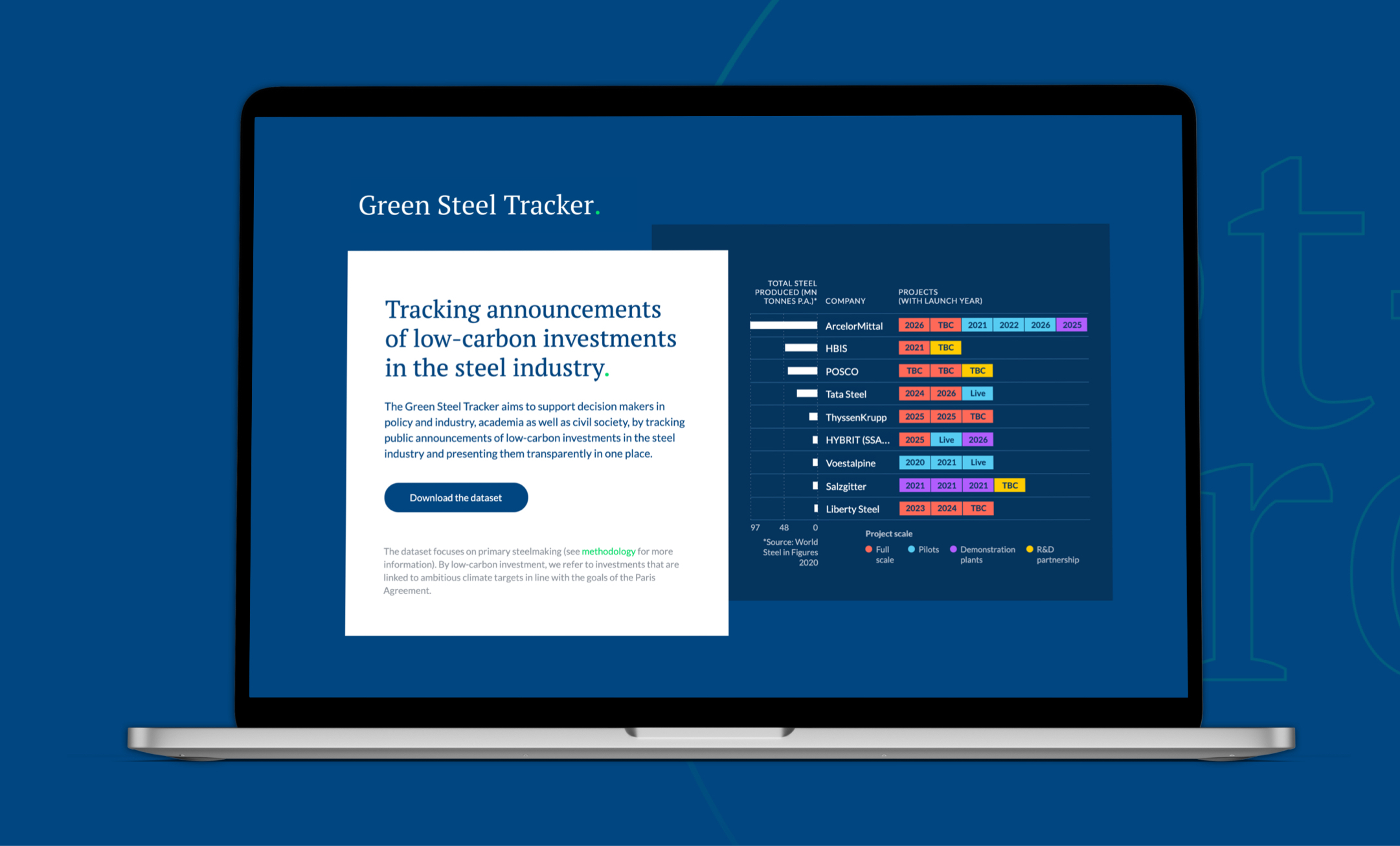Green Steel Tracker.
Methodology (this version archived 13 Nov 2023).
This version of the methodology expired on 13 November 2023 and is archived here for transparency. Please visit this page for the new version.
Introduction
The climate targets of the Paris Agreement require that global human-made greenhouse gas emissions (GHG) peak as soon as possible, reach net-zero around 2050 and become negative thereafter (Rogelj et al. 2018). Many steel-producing countries have set net-zero targets, including the European Union member states, Japan, South Korea and the UK for 2050, China and Ukraine for 2060. In order to reach these targets, the global iron and steel industry must aim to eliminate its greenhouse gas emissions until mid-century. Technologically, this means that novel technologies will have to be deployed (Hasanbeigi, Arens & Price 2014; IEA 2020).
The Green Steel Tracker aims to provide support to decision-makers in policy, industry and academia – as well as to civil society – by tracking public announcements of low-carbon investments in the steel industry and presenting them transparently in one place. By “low-carbon investment”, we refer to investments that are linked to ambitious climate targets in line with the goals of the Paris Agreement. The climate targets can be company or national targets, and often these two are aligned as is visible in the data.

Scope
The dataset contains information on near-zero CO2 emission ambitions and investments in the global iron and steel industry, as well as the climate targets of associated steel producing companies. The focus lies on investments aiming to decarbonise primary steel (steelmaking from iron ore) production. Deep emission reductions in primary steel production require major modifications of the steel production process and are regarded as the prime challenge for the steel sector to meet the goals of the Paris Agreement. Secondary steelmaking (steelmaking from recycled scrap), on the other hand, can be decarbonised largely through using renewable electricity.
Only ambitious investments targets with a clear and transparent commitment plan are covered by the dataset. Incremental improvements and process optimisation in current steel mills are not regarded if they do not enable deep emission reductions. Projects aiming at continuing the use of fossil carbon are only included insofar as they include plans to either phase out fossil carbon in line with global climate targets or to permanently capture and store carbon emissions. In other words, these projects must address the reduction of scope 3 emissions. For example, direct reduction projects using natural gas are included, if the project has a commitment to replace natural gas with a near-zero emission energy carrier once it is available and with a mid-century decarbonisation timeline. The database also contains research and development partnerships so far as they have been linked to ambitious climate targets by large primary steel producers.
Sources
The data was collected through tracking industry announcements over time and represents the collective effort of several research groups. The initial data gathering was complemented by a web-based search to ensure that no projects were missed. This search was guided by the list of biggest steelmakers as provided by worldsteel (2020), keyword searches based on the data already assembled (for example “Tata Steel Hydrogen Pilot”) and screenings of media outlets that repeatedly reported on low-carbon steel industry investments. Complementarily, all primary steel production of companies rated at level 3 or 4 of the Transition Pathways Initiative were reviewed. The database will be updated quarterly after the initial launch.
Validation
Following an initial data gathering period, the findings were validated by a group of three of the authors by comparing the findings to company reporting, the IEA’s Hydrogen Projects Database, Table 4.2 “Status of main emerging technologies in the iron and steel sector” from IEA’s Energy and Technology Perspectives 2020 Report, Global Energy Monitor’s Global Steel Plant Tracker, and through web-based searching as well as survey results under the Carbon Disclosure Project.
Uncertainties
An inherent challenge in tracking publicly announced investments is their credibility and level of implementation. As far as available, information on project types, sizes and their implementation timeline is included in the dataset. The authors refrained from adding their own interpretation on the current status of individual projects and instead refer to the columns “comments” and “latest news” for users interested in the latest stage of project implementation.
Small projects with little media attention and confidential projects might have been overlooked. Users aware of projects not yet included can report them through https://www.industrytransition.org/green-steel-tracker/.
License
The dataset might be used by others under a CC BY license. It should be cited as:
Vogl, V, Sanchez, F, Gerres, T, Lettow, F, Bhaskar, A, Swalec, C, Mete, G, Åhman, M, Lehne, J, Schenk, S, Witecka, W, Olsson, O, Rootzén, J 2021, Green Steel Tracker, Version 04/2021, Stockholm, Dataset, https://www.industrytransition.org/green-steel-tracker/.
References
Hasanbeigi, A, Arens, M & Price, L 2014, ‘Alternative emerging ironmaking technologies for energy-efficiency and carbon dioxide emissions reduction: A technical review’, Renewable and Sustainable Energy Reviews, vol. 33, pp. 645-58.IEA 2020, Iron and Steel Roadmap, International Energy Agency, Paris.
Rogelj, J, Shindell, D, Jiang, K, Fifita, S, Forster, P, Ginzburg, V, Handa, C, Kheshgi, H, Kobayashi, S, Kriegler, E, Mundaca, L, Séférian, R & Vilariño, MV 2018, Mitigation Pathways Compatible with 1.5°C in the Context of Sustainable Development. In: Global Warming of 1.5°C. An IPCC Special Report on the impacts of global warming of 1.5°C above pre-industrial levels and related global greenhouse gas emission pathways, in the context of strengthening the global response to the threat of climate change, sustainable development, and efforts to eradicate poverty.
worldsteel 2020, 2020 World Steel in Figures, World Steel Association, Brussels.
